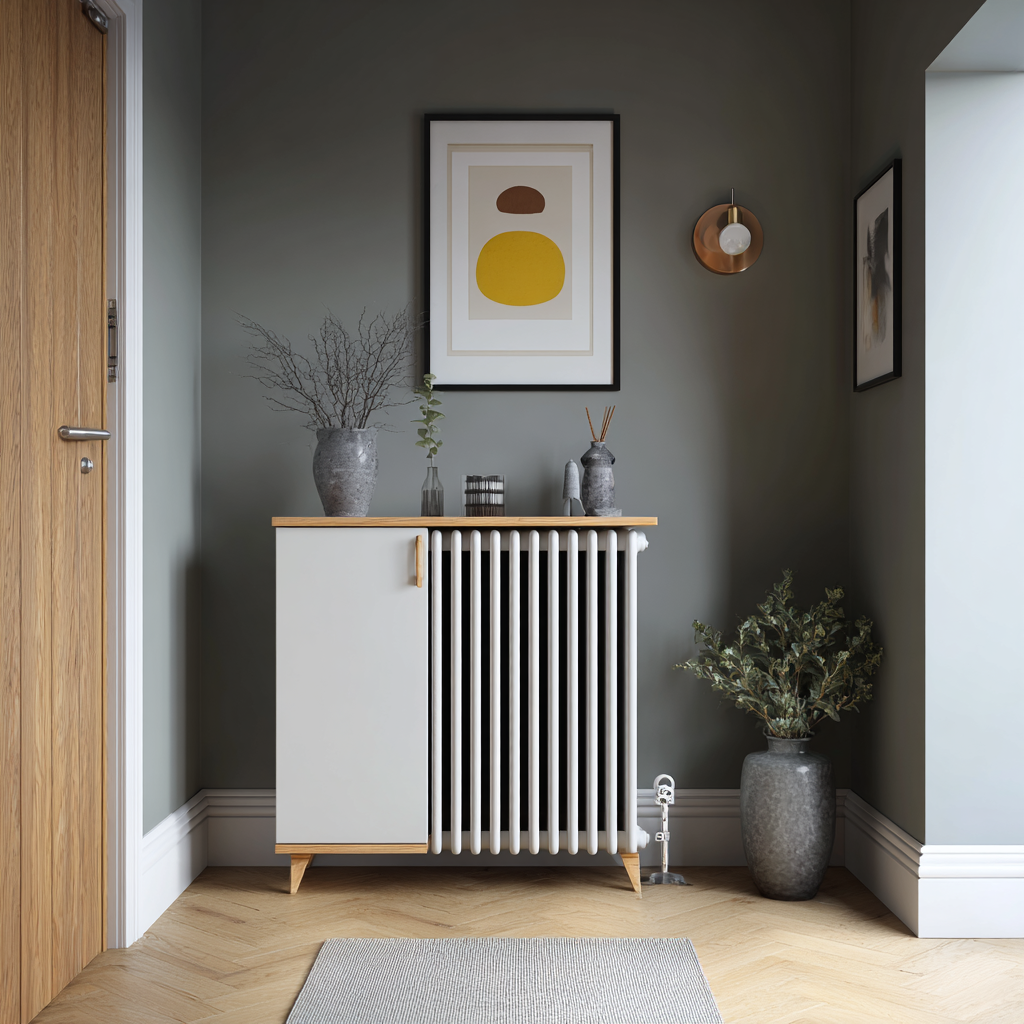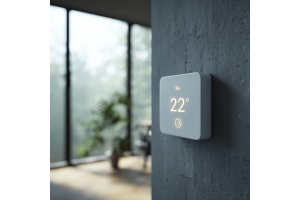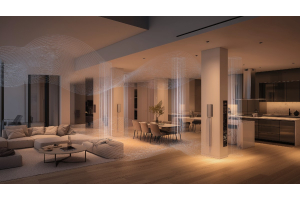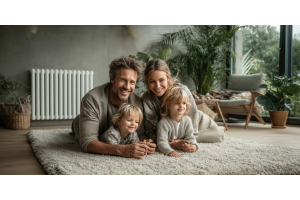
When it comes to keeping your home warm, you might think it’s all about the radiator’s size or efficiency. But even the best, most modern radiator can underperform if it’s in the wrong place. Poor placement can block heat, cause uneven warmth, and waste energy — leaving you paying more for less comfort.
In this guide, we’ll look at the most common radiator placement mistakes in UK homes, why they matter, and how to fix them.
1. Hiding Radiators Behind Furniture
The problem:
It’s a common interior design choice — placing a sofa, bed, or bulky cabinet in front of a radiator to make the room layout feel more open or symmetrical. While it might look tidy, this is one of the biggest radiator placement mistakes in UK homes.
Why it wastes heat:
Radiators work primarily through convection — heating the air around them, which rises and circulates throughout the room. When a large piece of furniture sits directly in front, it:
-
Absorbs the heat before it can circulate, meaning you’re paying to warm a piece of furniture instead of the air.
-
Slows down air movement, leading to cold spots in the rest of the room.
-
Can trick thermostatic radiator valves (TRVs) into shutting off early, as the area around the valve heats up quickly while the rest of the room remains chilly.
In practice, this often means you’ll turn up the thermostat or leave the heating on longer — driving up your energy bills and carbon footprint without actually feeling warmer.
Real-world example:
A three-seater sofa with a solid back can block as much as 40–50% of the heat output from a standard double panel radiator. That’s like paying for a high-efficiency system and then deliberately halving its performance.
How to fix it:
-
Maintain a clearance gap: Ideally, keep 30–45 cm (12–18 inches) between the radiator and large furniture. Even a 15 cm gap can make a big difference to airflow.
-
Reconfigure your layout: Consider placing furniture at right angles to the radiator so warm air flows into the centre of the room.
-
Use vertical radiators: If space is tight, a tall, slim radiator can fit in narrow wall spaces that are less likely to be blocked.
-
Install radiator shelves: These help direct heat outwards into the room and can protect nearby furniture from heat damage.
-
Switch to a convector or fan-assisted radiator: If moving furniture is impossible, a low-profile unit with built-in fans can help push warm air into circulation.
Extra tip for period properties:
In older homes where radiator positions are hard to change, reflective radiator panels behind the unit can help bounce heat forward into the room instead of being absorbed into furniture or walls.
2. Blocking Radiators with Curtains or Blinds
The problem:
Heavy floor-length curtains, thick Roman blinds, or layered window treatments can make a room feel luxurious — but when they hang over or in front of a radiator, they can trap heat where it’s least useful. This is one of the most common and costly heating inefficiencies in UK homes, especially in older properties with radiators placed directly beneath windows.
Why it wastes heat:
Radiators work by warming the cooler air that enters the room, often from draughty windows. When curtains or blinds block that flow:
-
Heat becomes trapped between the radiator and the fabric, warming the window area rather than the living space.
-
Warm air circulation is cut off, meaning the rest of the room stays cooler for longer.
-
The heat can escape through poorly insulated glass before it ever benefits the room — especially in single-glazed or old sash windows.
In some cases, long curtains can act like a mini “heat pocket” — your radiator works overtime to heat that small enclosed space, while you’re left turning up the thermostat to feel comfortable.
Impact on bills & comfort:
Research from the Energy Saving Trust shows that poor radiator placement and heat obstruction can waste up to 25% of heating output. With energy prices high, that’s a significant cost over an entire winter season — money literally vanishing into thin (and cold) air.
How to fix it:
-
Shorten curtains to above radiator level: This allows warm air to rise and circulate freely into the room.
-
Switch to thermal blinds: These insulate windows without blocking radiator heat.
-
Install a radiator shelf: A simple shelf above the radiator can help direct heat away from the window and into the room, even if you keep longer curtains.
-
Use side tiebacks: During the day or when the heating is on, pull curtains wide open so the radiator is fully exposed.
-
Opt for slimline or vertical radiators: If you’re redecorating, move or replace radiators so they sit away from window areas, especially in rooms where you want long drapes.
Extra tip for winter efficiency:
If your radiator must stay under a window, combine a short curtain style with insulating window film or double glazing to reduce heat loss. This not only improves efficiency but also prevents condensation — a common issue when warm air gets trapped behind fabric near cold glass.
3. Placing Radiators on External Walls Without Insulation
The problem:
Many UK homes — particularly those built before the 1980s — have radiators positioned on external walls. Historically, this was done to counteract cold draughts from windows and outside walls. While this layout can still help combat chilly air entering the room, it comes with a major downside: heat loss through the wall itself.
When the wall isn’t insulated, a significant portion of the radiator’s warmth doesn’t make it into the room — it escapes directly into the outdoor environment. Essentially, you’re paying to heat the great outdoors.
Why it wastes heat:
-
Direct heat transfer: Radiators radiate warmth in all directions — including backwards. Without insulation, this heat moves through the wall and dissipates outside.
-
Cold bridging: External walls can act like a “heat highway,” quickly drawing warmth away from the radiator and the indoor air.
-
Increased boiler workload: The heating system works harder and for longer to reach your desired room temperature.
-
Reduced comfort levels: Even with the heating on, the area near the radiator can feel cooler due to the cold wall surface.
According to the Energy Saving Trust, uninsulated solid walls can lose twice as much heat as uninsulated cavity walls, making this an expensive inefficiency over the long term.
Signs your radiator may be losing heat to an external wall:
-
The wall behind the radiator feels cold to the touch even when the radiator is hot.
-
Your heating bills are higher than expected despite having an efficient system.
-
Rooms with external-wall radiators take noticeably longer to warm up compared to other rooms.
How to fix it:
-
Install reflective radiator panels: A simple, inexpensive fix that reflects heat back into the room instead of letting it pass into the wall. Look for high-quality foil-backed insulation boards rather than basic thin foil sheets for best results.
-
Upgrade wall insulation:
-
Cavity wall insulation — Ideal if your home was built after the 1920s and has a cavity wall structure.
-
Solid wall insulation — Either internal (adding insulated plasterboard) or external (insulating cladding) can drastically reduce heat loss.
-
-
Relocate the radiator: If you’re planning major renovations, consider moving the radiator to an internal wall, where heat retention is much better.
-
Combine with thermostatic radiator valves (TRVs): This allows more precise control, preventing overcompensation for heat lost through the wall.
Extra tip for listed or period properties:
If you can’t install conventional insulation due to building restrictions, reflective panels and bespoke insulated radiator covers can help preserve the building’s character while boosting efficiency.
4. Installing Radiators Too Close to the Floor or Ceiling
The problem:
Radiators are designed to heat a room by warming the surrounding air, which then circulates naturally. Warm air rises, cooler air falls — and this convection cycle is what evenly distributes heat. But when a radiator is installed too close to the floor or ceiling, this natural airflow is disrupted.
A radiator placed too low can have restricted airflow underneath, while one installed too high may allow most of the heat to rise to the ceiling before it benefits people sitting or moving around the room. Either way, it leads to uneven heating and wasted energy.
Why it wastes heat:
-
Too low to the floor:
-
Limits the movement of cooler air into the bottom of the radiator.
-
Can cause warm air to stagnate directly above the radiator instead of circulating into the room.
-
More likely to be blocked by skirting boards or flooring features.
-
-
Too high on the wall:
-
Radiates heat into the upper part of the room, which is wasted since people spend their time lower down.
-
Forces you to keep heating longer to feel comfortable at seating or standing height.
-
Can leave lower parts of the room feeling cold, prompting you to increase thermostat settings unnecessarily.
-
The ideal radiator height:
Industry best practice recommends installing radiators with the bottom edge around 100–150mm (4–6 inches) above the floor. This gap allows cool air to be drawn in from below, heated efficiently, and then rise naturally into the room.
For taller vertical radiators, positioning still matters — the middle of the radiator should ideally be around at chest height to ensure even distribution, while keeping the base elevated for airflow.
Real-world impacts:
-
Comfort: Poor placement can create hot and cold zones, meaning you feel warm in one part of the room but chilly in another.
-
Energy efficiency: Your heating system works harder and longer to deliver the same comfort, increasing energy bills.
-
System wear and tear: Running the heating more often increases strain on the boiler or heating elements.
How to fix it:
-
Check radiator height during installation: Always measure clearance from both the floor and ceiling before mounting.
-
Use wall brackets or radiator feet: These allow adjustments in height without major plumbing work.
-
Combine with fans or radiator boosters: If your radiator is already fixed too high, a small, low-energy fan can help push warm air down into the occupied space.
-
Consider radiator type: For rooms with unusual layouts, low-profile radiators or skirting board heaters can work better without wasting heat.
Extra tip for homeowners:
If you’re replacing flooring or redecorating, that’s the perfect time to assess radiator height — small adjustments now can save money and improve comfort for years.
5. Placing Radiators in Narrow or Enclosed Spaces
The problem:
Radiators need open airflow to work effectively. If they’re installed in narrow alcoves, tucked into boxed-in recesses, or surrounded by built-in shelving or furniture, their ability to distribute heat evenly is compromised. The warm air they generate becomes trapped in that confined space, meaning less warmth reaches the rest of the room.
This placement mistake is common in older homes with chimney breast alcoves, where radiators are often squeezed into recesses to “hide” them — a decision that might look tidy but comes at a big cost in heating efficiency.
Why it wastes heat:
-
Restricted airflow: Heat rises into the enclosed space and lingers there instead of circulating.
-
Microclimate effect: The small space warms quickly, tricking thermostats (especially if a TRV is attached) into thinking the room is heated when it’s not.
-
Heat absorption: Nearby walls, cabinetry, or shelving can absorb and store the heat, especially if they’re made from dense materials like wood or brick.
-
Delayed heating response: Because heat isn’t moving freely, it takes longer to raise the room temperature — which means the heating system runs longer.
Common locations where this happens:
-
Chimney breast alcoves in Victorian and Edwardian homes.
-
Under worktops in kitchens.
-
In fitted cupboards or shelving units where aesthetics are prioritised over airflow.
-
Narrow hallways with wall protrusions or doorframes restricting circulation.
The ideal solution:
When planning radiator placement, the goal is to give them as much open, unobstructed space as possible. Radiators should have free space above, below, and to the sides so heat can spread naturally throughout the room.
How to fix or improve performance in enclosed spaces:
-
Relocate the radiator:
-
Move it to a more open wall — ideally under a window (with proper insulation behind) where rising warm air can mix with cooler air from the glass.
-
-
Increase clearance:
-
If relocation isn’t possible, adjust shelving or cabinetry to create a gap of at least 100mm (4 inches) above and beside the radiator.
-
-
Use reflective radiator panels:
-
Especially useful in alcoves with external walls, these reflect heat into the room instead of letting it sink into surrounding surfaces.
-
-
Improve airflow mechanically:
-
Install a low-energy radiator fan or booster at the base to push warm air out into the room.
-
Small, silent units can be highly effective in overcoming airflow restrictions.
-
-
Choose a radiator designed for confined spaces:
-
Vertical radiators work better in narrow wall areas.
-
Low-profile convectors can be positioned under shelves or sills while still delivering effective heat.
-
Extra tip for thermostat placement:
If your radiator is enclosed and has a TRV, consider placing the thermostat sensor outside the enclosure to ensure it measures the true room temperature rather than the warm air trapped in the alcove.
6. Forgetting About Airflow in Open-Plan Spaces
The problem:
Open-plan living is stylish and modern, but it creates unique heating challenges. Without interior walls to trap heat, warm air can drift into unused areas, and cooler drafts can move freely through the space. If radiator placement doesn’t account for these airflows, large open areas can develop hot and cold zones, forcing you to run the heating for longer and at higher temperatures to feel comfortable.
A common mistake is treating an open-plan room like a smaller, enclosed space — positioning radiators in convenient or aesthetically pleasing spots without thinking about how air will circulate across the whole area.
Why it wastes heat:
-
Heat loss through poor zoning: Without walls to contain warmth, heat can dissipate into less-used parts of the room (or up staircases) instead of staying where it’s needed.
-
Unbalanced warmth: One side of the space might be toasty while the far end remains cold, prompting people to overheat the warmer section just to make the colder section tolerable.
-
Blocked circulation paths: Large furniture, kitchen islands, or even glass partitions can interrupt airflow and trap heat away from where people spend the most time.
Common open-plan airflow mistakes:
-
Placing all radiators on one wall rather than distributing them around the room.
-
Positioning a single large radiator near the entrance or staircase, letting heat escape to other floors.
-
Failing to use natural convection paths, such as placing a radiator under a window where cool air enters.
How to optimise radiator placement for open-plan spaces:
-
Distribute heat sources evenly
-
Instead of one large radiator, consider multiple smaller units placed strategically across the space.
-
This prevents one area from overheating while others stay cold.
-
-
Zone your heating system
-
Use thermostatic radiator valves (TRVs) or smart zoning controls to heat only the areas in use.
-
For example, warm the kitchen area in the morning but keep the lounge section cooler until evening.
-
-
Use vertical radiators for tall walls
-
In spaces with high ceilings, vertical radiators can push warm air higher and promote better circulation without taking up much floor space.
-
-
Create subtle airflow guides
-
Open shelving, half-height partitions, or strategically placed rugs can influence air movement without fully blocking it.
-
This helps trap warmth in certain “zones” without losing the open-plan feel.
-
-
Prevent heat from escaping upstairs
-
If your open-plan area connects to an open staircase, install a radiator further from the stairwell or use a heat curtain (transparent or fabric) in winter to stop warmth from drifting upward.
-
-
Combine with ceiling fans or low-energy air circulators
-
These can gently push warm air downwards and across the space, reducing cold spots.
-
Extra tip:
In open-plan rooms with large glass areas, consider placing radiators near external walls or windows. This combats the natural cooling effect from the glass and ensures warm air mixes more effectively with cooler incoming drafts.
7. Ignoring Sunlight & Solar Gain
The problem:
Natural sunlight is a free heat source — and in the UK, even a weak winter sun can significantly warm a room during the day. But many homeowners position radiators without considering how sunlight will interact with the space. If radiators are placed where they are constantly in direct sunlight, the room’s temperature can artificially spike, tricking thermostatic radiator valves (TRVs) or smart thermostats into shutting off the heating prematurely.
The opposite can also happen: failing to place radiators where the sun never reaches can leave certain corners of a room permanently chilly, meaning you run the heating longer than necessary.
Why it wastes heat:
-
False temperature readings: TRVs placed on sunlit radiators register higher-than-actual room temperatures, reducing heat output while the rest of the room remains cold.
-
Uneven heating: Rooms that receive uneven sunlight (e.g., one side facing south, the other facing north) can create warm and cold zones if radiator placement doesn’t balance the difference.
-
Underuse of free heat: Poor radiator positioning means you fail to take advantage of the warmth the sun already provides, relying more heavily on paid heating.
Common mistakes homeowners make:
-
Installing radiators on south-facing walls in full sun, causing TRVs to shut off too early.
-
Putting the main heat source in the shadiest part of a sunny room, making the heating system work harder even when sunlight is helping.
-
Not considering seasonal sun paths — a spot that’s sunlit in summer may be in shadow during winter.
How to optimise radiator placement with solar gain in mind:
-
Avoid constant direct sunlight on TRVs
-
Place radiators where their thermostatic controls won’t be affected by direct rays. If unavoidable, use remote TRV sensors placed elsewhere in the room for accurate readings.
-
-
Balance sunny and shady areas
-
In rooms with uneven sunlight, install radiators on the cooler side to ensure heat is distributed evenly.
-
If the sunny side gets warm naturally, you can use smaller radiators there or rely on passive heating during the day.
-
-
Plan for the seasonal sun path
-
In winter, the sun is lower, so light enters deeper into the room — you can take advantage of this by allowing sunlight to warm areas where people spend time.
-
In summer, this same spot might overheat, so ensure you have blinds or light curtains to control it.
-
-
Use sunlight as part of your heating strategy
-
On bright winter days, keep curtains open to boost warmth naturally and reduce radiator workload.
-
When sunlight is strong enough to raise room temperatures above the thermostat setting, consider switching off heating entirely for that zone.
-
-
Consider reflective and insulating surfaces
-
Light-coloured walls and reflective radiator panels can help bounce solar warmth deeper into the room, while insulated curtains at night prevent heat loss once the sun goes down.
-
Extra tip:
If you’re installing smart heating controls, check if they offer a “solar gain compensation” feature. This adjusts heating schedules automatically when sunlight is warming the room, preventing overheating and wasted energy.
8. Not Considering Future Room Layout Changes
The problem:
When homeowners renovate, redecorate, or buy new furniture, radiator placement often gets overlooked — until it’s too late. A radiator that’s ideally positioned today can become inefficient or obstructed tomorrow if the room layout changes. For example, adding a large sofa, built-in storage, or a media unit could block airflow. Even switching the use of a room (like turning a dining room into a home office) might mean the radiator is now heating an area that people rarely occupy.
Failing to plan for future flexibility can lead to wasted heat, reduced comfort, and costly relocation work later.
Why it wastes heat:
-
Blocked airflow: New furniture or storage units placed in front of a radiator can trap heat, preventing it from circulating.
-
Uneven heating: A radiator positioned for the original layout may not match the new arrangement of seating or work areas, meaning warm air doesn’t reach where it’s needed most.
-
Unnecessary relocation costs: Moving a radiator after redecorating often involves draining the system, rerouting pipework, and redecorating — a costly and disruptive job.
-
Energy inefficiency: If the radiator is forced to heat a blocked or unused space, you end up running the heating longer and spending more.
Common scenarios where layout changes cause heating problems:
-
Furniture upgrades: Swapping out a small armchair for a large corner sofa that now covers half the radiator.
-
Changing room function: Turning a guest bedroom into a home office, where the desk sits in a cold corner far from the existing heat source.
-
Adding built-in features: Installing wardrobes, cabinets, or TV units that encroach on radiator space.
-
Open-plan conversions: Removing walls can leave radiators in less strategic spots, reducing overall heat distribution.
-
Window changes: Moving or enlarging windows may change the optimal spot for a radiator (often previously under the window).
How to future-proof radiator placement:
-
Think long-term during installation
-
Even if you’re happy with the current room layout, imagine at least two possible future arrangements for furniture.
-
Place radiators where they’re least likely to be blocked in any configuration.
-
-
Consider centralised placement
-
Radiators in the middle of a wall (rather than tucked into a corner) are often more adaptable to layout changes.
-
Avoid installing them where large furniture is likely to be positioned, such as behind the main sofa in a living room.
-
-
Choose flexible radiator types
-
Vertical radiators can free up floor space and are less likely to be blocked by furniture.
-
Low-level radiators under windows tend to remain clear, as windows are rarely blocked by tall furniture.
-
-
Use modular or electric radiators
-
Modular systems allow you to add or move heating elements without major plumbing changes.
-
Electric radiators don’t rely on fixed pipework, offering more flexibility if the room’s purpose changes.
-
-
Leave clearance space
-
Even if you think you won’t block the radiator, maintain a minimum 300mm clearance in front to ensure airflow in the future.
-
Pro tip for homeowners:
If you’re renovating, mark potential furniture zones on the floor plan before installing radiators. This ensures heat sources will always be in useful positions, saving you the frustration — and expense — of a mid-winter heating rethink.
Final Thoughts: Placement Matters as Much as Performance
When most homeowners think about upgrading their heating, they focus on radiator style, size, and efficiency rating — and while those factors matter, placement is just as crucial to overall performance. Even the most advanced, energy-efficient radiator can’t do its job properly if it’s hidden behind furniture, trapped behind thick curtains, or stuck in a corner where heat can’t circulate freely.
Radiator positioning isn’t just a question of comfort — it’s about energy efficiency, running costs, and long-term usability. Poor placement can lead to:
-
Longer heating times, as the warmth struggles to spread evenly across the room.
-
Wasted energy, with heat being absorbed into walls, furniture, or lost out of windows.
-
Higher bills, as you end up running the heating more often and for longer periods.
-
Premature upgrades or relocations, costing you more in the long run.
Think of radiator placement as part of your home’s heating strategy, not just an afterthought during decorating. By combining the right radiator type with the right location, you can:
-
Improve overall heat distribution.
-
Reduce cold spots and draughty areas.
-
Lower your carbon footprint by avoiding wasted energy.
-
Create a more comfortable, evenly heated living space.
Key takeaways for homeowners:
-
Plan early — consider radiator placement during renovations or before buying new furniture.
-
Think ahead — leave flexibility for possible future layout changes.
-
Mind airflow — ensure radiators have space to “breathe” and circulate heat.
-
Work with your home’s features — use window placements, natural sunlight, and insulation to your advantage.
At the end of the day, a well-placed average radiator will often outperform a poorly placed premium one. Getting both right — performance and positioning — is the winning formula for warmth without waste.







